A New Method for Extracting Laver Culture Carriers Based on Inaccurate Supervised Classification with FCN-CRF
Abstract
1. Introduction
2. Materials and Methods
2.1. Materials
2.2. Principle
2.2.1. FCN
2.2.2. CRF
2.3. Methods
2.3.1. Image Preprocessing
2.3.2. FCN Training and Classification
2.3.3. Accuracy Evaluation
2.3.4. CRF Post-Processing and the Number and Area Calculation of Aquaculture Nets
3. Results
3.1. Preparation for the Experiment
3.2. Extracting Aquaculture Areas with FCN
3.3. Extracting Laver Aquaculture Nets with CRF
4. Discussion
5. Conclusions
Author Contributions
Funding
Acknowledgments
Conflicts of Interest
References
- Keesing, J.K.; Liu, N.; Fearns, P.; Garcia, R. Inter- and intra-annual patterns of Ulva prolifera green tides in the Yellow Sea during 2007–2009, their origin and relationship to the expansion of coastal seaweed aquaculture in China. Mar. Pollut. Bull. 2011, 62, 1169–1182. [Google Scholar] [CrossRef] [PubMed]
- Chua, T.-E. Coastal aquaculture development and the environment. Mar. Pollut. Bull. 1992, 25, 98–103. [Google Scholar] [CrossRef]
- Lu, X.; Gu, Y.; Wang, X.J.; Lin, Y.L.; Zhao, Q.; Wang, K.; Liu, X.N.; Fei, X.Y. The identification of Porphyra culture area by remote sensing and spatial distribution change and driving factors analysis. Mar. Sci. 2018, 42, 87–96. [Google Scholar]
- Lu, Y.W.; Li, Q.Z.; Du, X.; Wang, H.Y.; Liu, J.L. A Method of Coastal Aquaculture Area Automatic Extraction with High Spatial Resolution Images. Remote Sens. Technol. Appl. 2015, 30, 486–494. [Google Scholar]
- Rajitha, K.; Mukherjee, C.; Chandran, R.V. Applications of remote sensing and GIS for sustainable management of shrimp culture in India. Aquac. Eng. 2007, 36, 1–17. [Google Scholar] [CrossRef]
- Pattanaik, C.; Prasad, S.N. Assessment of aquaculture impact on mangroves of Mahanadi delta (Orissa), East coast of India using remote sensing and GIS. Ocean Coast. Manag. 2011, 54, 789–795. [Google Scholar] [CrossRef]
- Zhou, X.C.; Wang, X.Q.; Xiang, T.L.; Jiang, H. Method of Automatic Extracting Seaside Aquaculture Land Based on A STER Remote Sensing Image. Wetland Sci. 2006, 4, 64–68. [Google Scholar] [CrossRef]
- Wang, M.; Cui, Q.; Wang, J.; Ming, D.; Lv, G. Raft cultivation area extraction from high resolution remote sensing imagery by fusing multi-scale region-line primitive association features. ISPRS J. Photogramm. Remote Sens. 2017, 123, 104–113. [Google Scholar] [CrossRef]
- Xie, Y.L.; Wang, M.; Zhang, X.Y. An Object-oriented Approach for Extracting Farm Waters within Coastal Belts. Remote Sens. Technol. Appl. 2009, 24, 68–72. [Google Scholar]
- Hao, X.; Zhang, G.; Ma, S. Deep Learning. Int. J. Semantic Comput. 2016, 10, 417–439. [Google Scholar] [CrossRef]
- Torrisi, M.; Pollastri, G.; Le, Q. Deep learning methods in protein structure prediction. Comput. Struct. Biotechnol. J. 2020, 521, 436. [Google Scholar] [CrossRef]
- Botvinick, M.M.; Plaut, D.C. Short-term memory for serial order: A recurrent neural network model. Psychol. Rev. 2006, 113, 201–233. [Google Scholar] [CrossRef] [PubMed]
- Gers, F.A.; Schraudolph, N.N.; Schmidhuber, J. Learning Precise Timing with LSTM Recurrent Networks. J. Mach. Learn. Res. Appl. Phys. Lett. 2000, 3, 115–143. [Google Scholar]
- Chen, E.; Yang, X.; Zha, H.; Zhang, R.; Zhang, W. Learning object classes from image thumbnails through deep neural networks. In Proceedings of the 2008 IEEE International Conference on Acoustics, Speech and Signal Processing, Las Vegas, NV, USA, 31 March–4 April 2008; pp. 829–832. [Google Scholar]
- LeCun, Y.; Boser, B.; Denker, J.S.; Henderson, D.; Howard, R.E.; Hubbard, W.; Jackel, L.D. Backpropagation Applied to Handwritten Zip Code Recognition. Neural Comput. 1989, 1, 541–551. [Google Scholar] [CrossRef]
- LeCun, Y.; Bottou, L.; Bengio, Y.; Haffner, P. Gradient-based learning applied to document recognition. Proc. IEEE 1998, 86, 2278–2324. [Google Scholar] [CrossRef]
- Krizhevsky, A.; Sutskever, I.; Hinton, G.E. Pdf ImageNet classification with deep convolutional neural networks. Commun. ACM 2017, 60, 84–90. [Google Scholar] [CrossRef]
- Shelhamer, E.; Long, J.; Darrell, T. Fully Convolutional Networks for Semantic Segmentation. IEEE Trans. Pattern Anal. Mach. Intell. 2017, 39, 640–651. [Google Scholar] [CrossRef]
- Dai, J.; He, K.; Li, Y.; Ren, S.; Sun, J. Instance-Sensitive Fully Convolutional Networks. In Proceedings of the Computer Vision—ECCV 2016, Amsterdam, The Netherlands, 11–14 October 2016; Leibe, B., Matas, J., Sebe, N., Welling, M., Eds.; Springer: Cham, Switzerland, 2016; Volume 9910, pp. 534–549. [Google Scholar] [CrossRef]
- Henry, C.; Azimi, S.M.; Merkle, N. Road Segmentation in SAR Satellite Images with Deep Fully Convolutional Neural Networks. IEEE Geosci. Remote Sens. Lett. 2018, 15, 1867–1871. [Google Scholar] [CrossRef]
- Zhang, J.; Pan, J.; Lai, W.-S.; Lau, R.W.H.; Yang, M.-H. Learning Fully Convolutional Networks for Iterative Non-blind Deconvolution. In Proceedings of the 2017 IEEE Conference on Computer Vision and Pattern Recognition (CVPR), Honolulu, HI, USA, 21–26 July 2017; pp. 6969–6977. [Google Scholar]
- Ronneberger, O.; Fischer, P.; Brox, T. U-net: Convolutional networks for biomedical image segmentation. In Proceedings of the Medical Image Computing and Computer-Assisted Intervention—MICCAI 2015, Munich, Germany, 5–9 October 2015; Navab, N., Hornegger, J., Wells, W., Frangi, A., Eds.; Springer: Cham, Switzerland, 2015; Volume 9351, pp. 234–241. [Google Scholar] [CrossRef]
- Badrinarayanan, V.; Badrinarayanan, V.; Cipolla, R. SegNet: A Deep Convolutional Encoder-Decoder Architecture for Image Segmentation. IEEE Trans. Pattern Anal. Mach. Intell. 2017, 39, 2481–2495. [Google Scholar] [CrossRef]
- Wang, Z. On zero distribution of a class of continuous functions. Complex Var. Theory Appl. Int. J. 1987, 7, 357–361. [Google Scholar] [CrossRef]
- Chen, L.-C.; Papandreou, G.; Kokkinos, I.; Murphy, K.; Yuille, A.L. DeepLab: Semantic Image Segmentation with Deep Convolutional Nets, Atrous Convolution, and Fully Connected CRFs. IEEE Trans. Pattern Anal. Mach. Intell. 2018, 40, 834–848. [Google Scholar] [CrossRef] [PubMed]
- Shafiee, M.J.; Wong, A.; Fieguth, P.W. Deep Randomly-Connected Conditional Random Fields for Image Segmentation. IEEE Access 2016, 5, 366–378. [Google Scholar] [CrossRef]
- Song, R.; Liu, Y.; Zhao, Y.; Martin, R.R.; Rosin, P.L. Conditional random field-based mesh saliency. In Proceedings of the 2012 19th IEEE International Conference on Image Processing, Orlando, FL, USA, 30 September–3 October 2012; Volume 3, pp. 637–640. [Google Scholar]
- Scharstein, D.; Pal, C. Learning Conditional Random Fields for Stereo. In Proceedings of the 2007 IEEE Conference on Computer Vision and Pattern Recognition, Minneapolis, MN, USA, 18–23 June 2007; pp. 1–8. [Google Scholar]
- Zhai, J.; Li, H. An Improved Full Convolutional Network Combined with Conditional Random Fields for Brain MR Image Segmentation Algorithm and its 3D Visualization Analysis. J. Med. Syst. 2019, 43, 292. [Google Scholar] [CrossRef] [PubMed]
- Krähenbühl, P.; Koltun, V. Efficient Inference in Fully Connected CRFs with Gaussian Edge Potentials. NIPS 2012, 109–117. [Google Scholar]
- Zheng, S.; Jayasumana, S.; Romera-Paredes, B.; Vineet, V.; Su, Z.; Du, D.; Huang, C.; Torr, P.H.S.; Shuai, Z.; Sadeep, J.; et al. Conditional Random Fields as Recurrent Neural Networks. In Proceedings of the 2015 IEEE International Conference on Computer Vision (ICCV), Santiago, Chile, 7–13 December 2015; pp. 1529–1537. [Google Scholar]
- Pei, L.; Liu, Y.; Gao, L. Cloud Detection of ZY-3 Remote Sensing Images Based on Fully Convolutional Neural Network and Conditional Random Field. Laser Optoelectron. Prog. 2019, 56, 269–275. [Google Scholar]
- Hong, M.J.; Wang, H.L.; Huang, N.J.; Dai, S. A Lane Detection Algorithm Based on FCN. Radio Commun. Technol. 2018, 44, 0587–0592. [Google Scholar]
- Cui, B.-G.; Zhong, Y.; Fei, D.; Zhang, Y.-H.; Liu, R.-J.; Chu, J.-L.; Zhao, J.-H. Floating Raft Aquaculture Area Automatic Extraction Based on Fully Convolutional Network. J. Coast. Res. 2019, 90, 86–94. [Google Scholar] [CrossRef]
- Sui, B.; Jiang, T.; Zhang, Z.; Pan, X.; Liu, C. A Modeling Method for Automatic Extraction of Offshore Aquaculture Zones Based on Semantic Segmentation. ISPRS Int. J. Geo-Inf. 2020, 9, 145. [Google Scholar] [CrossRef]
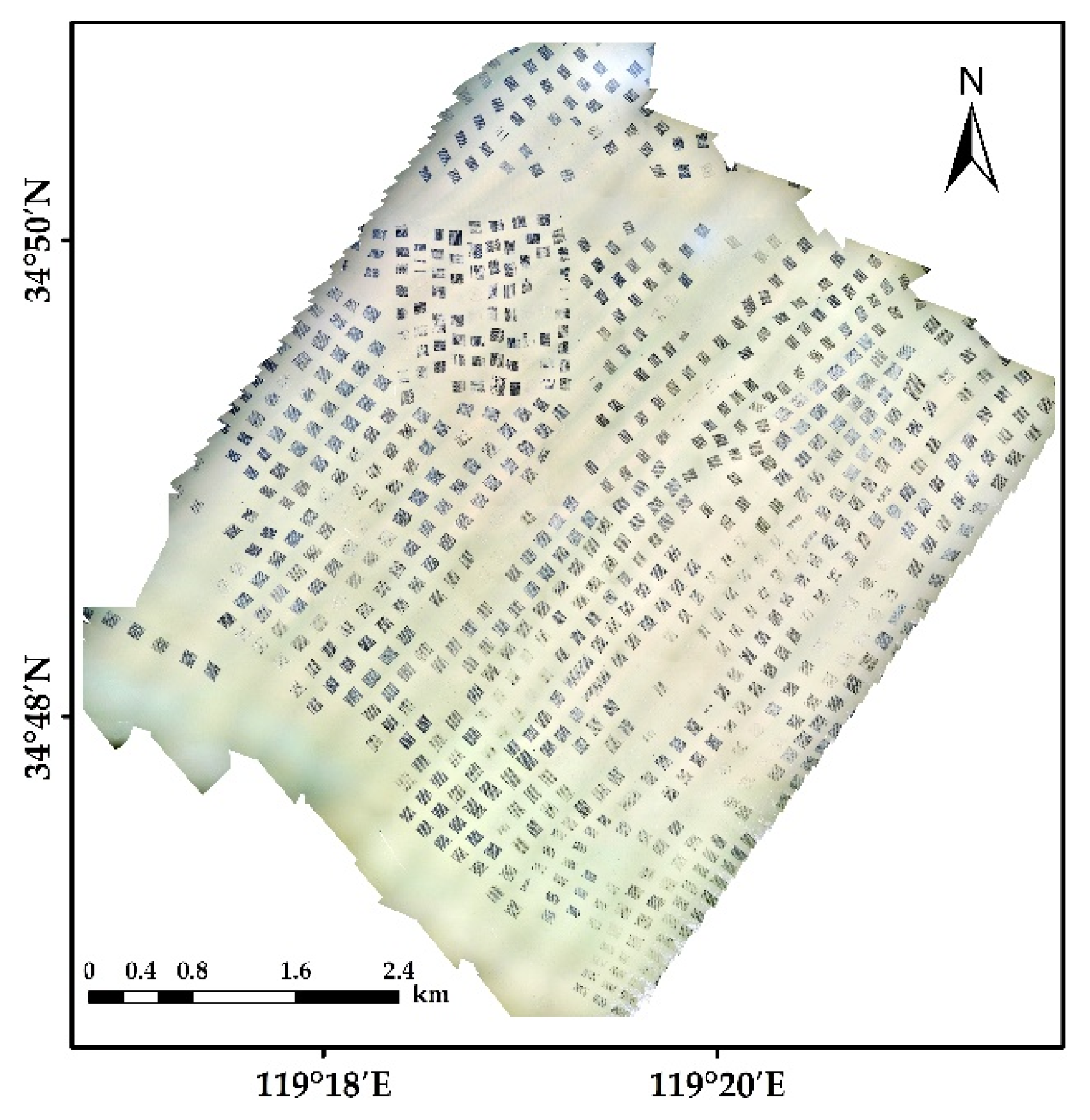
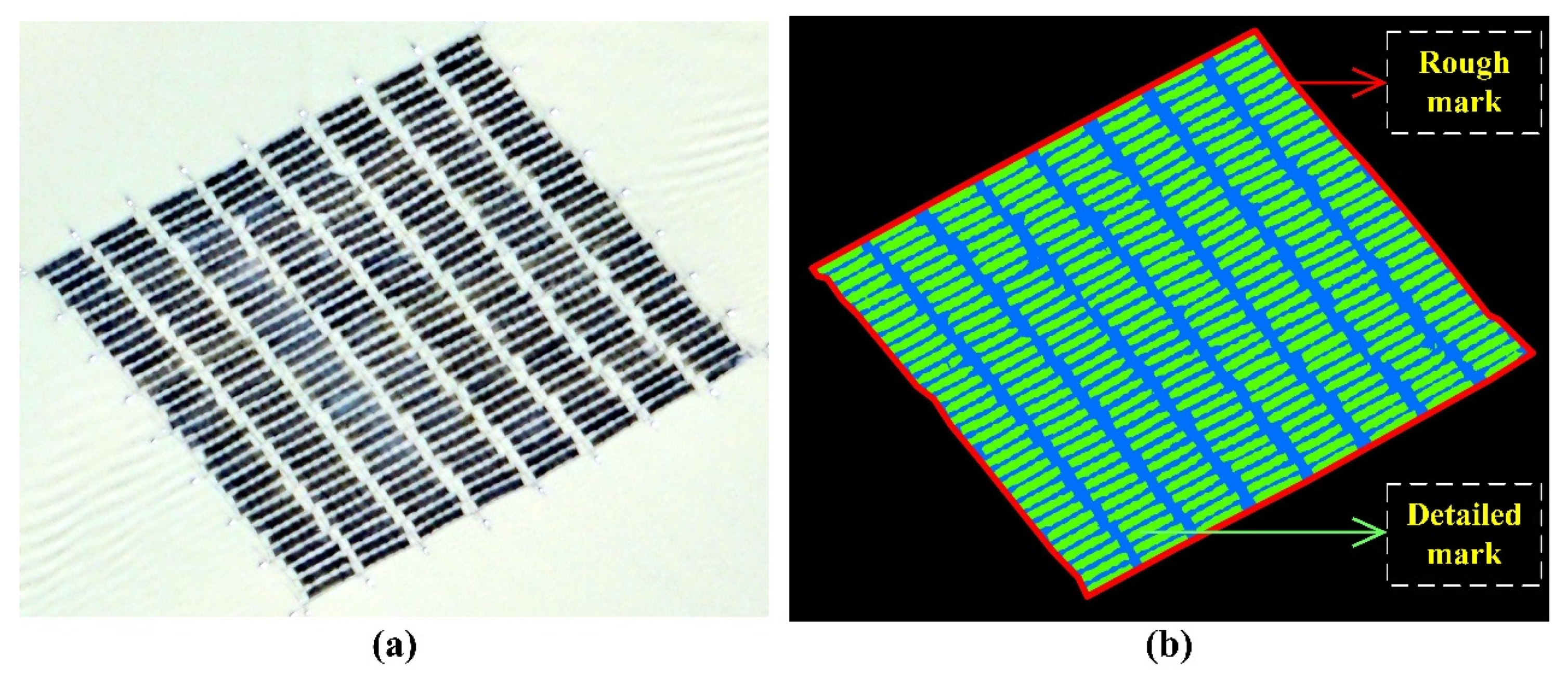
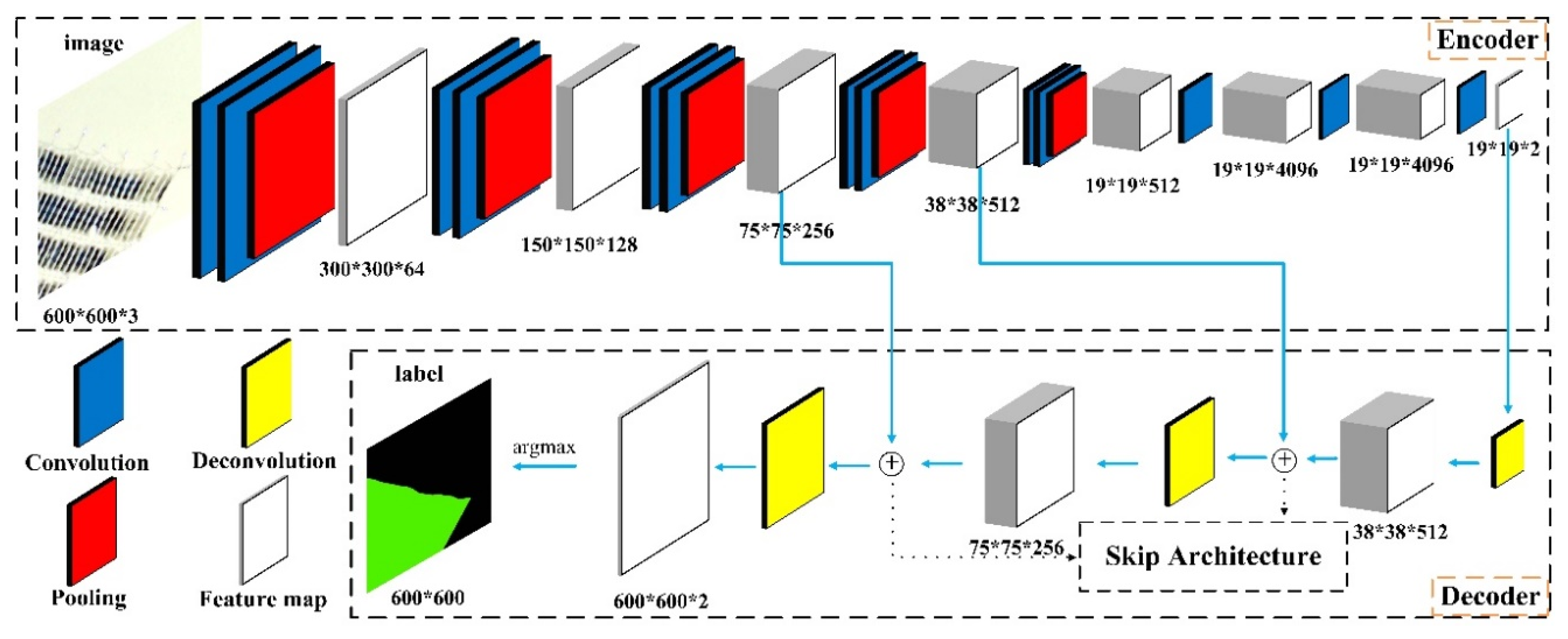
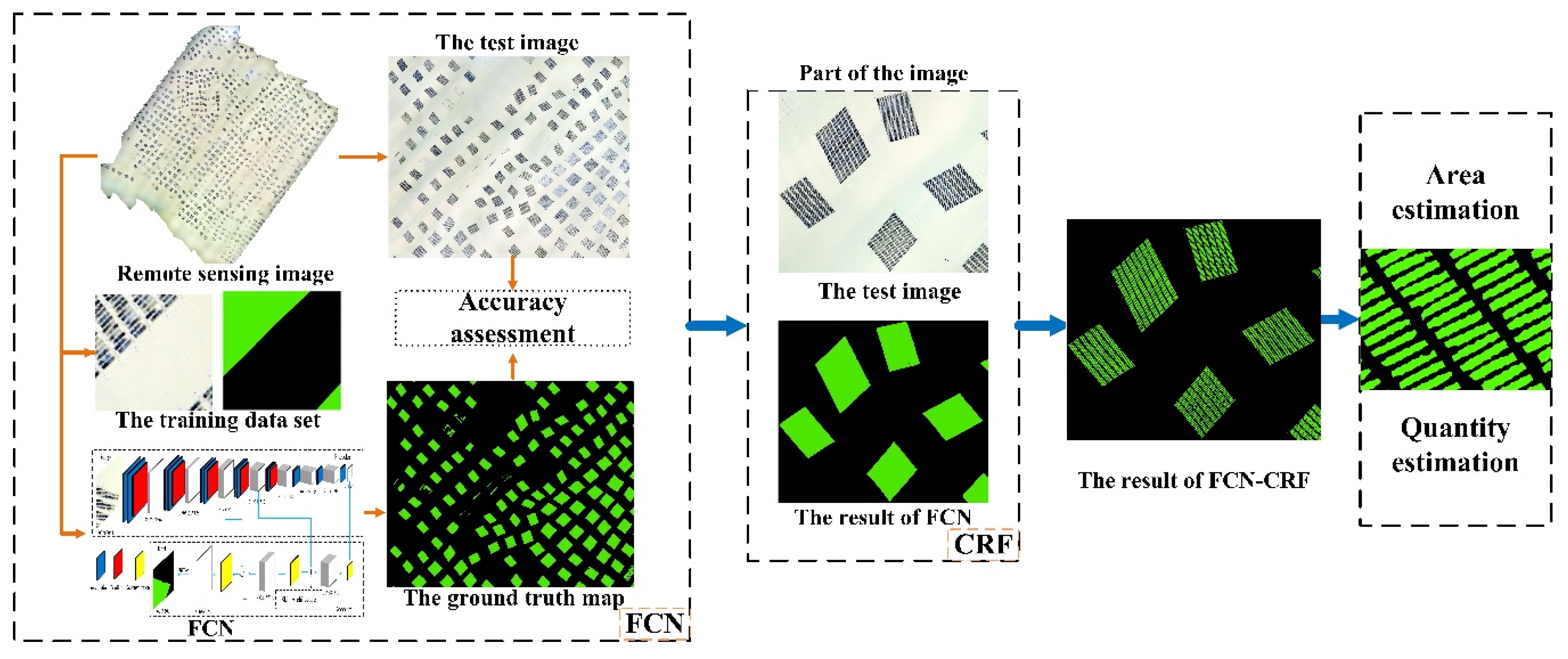
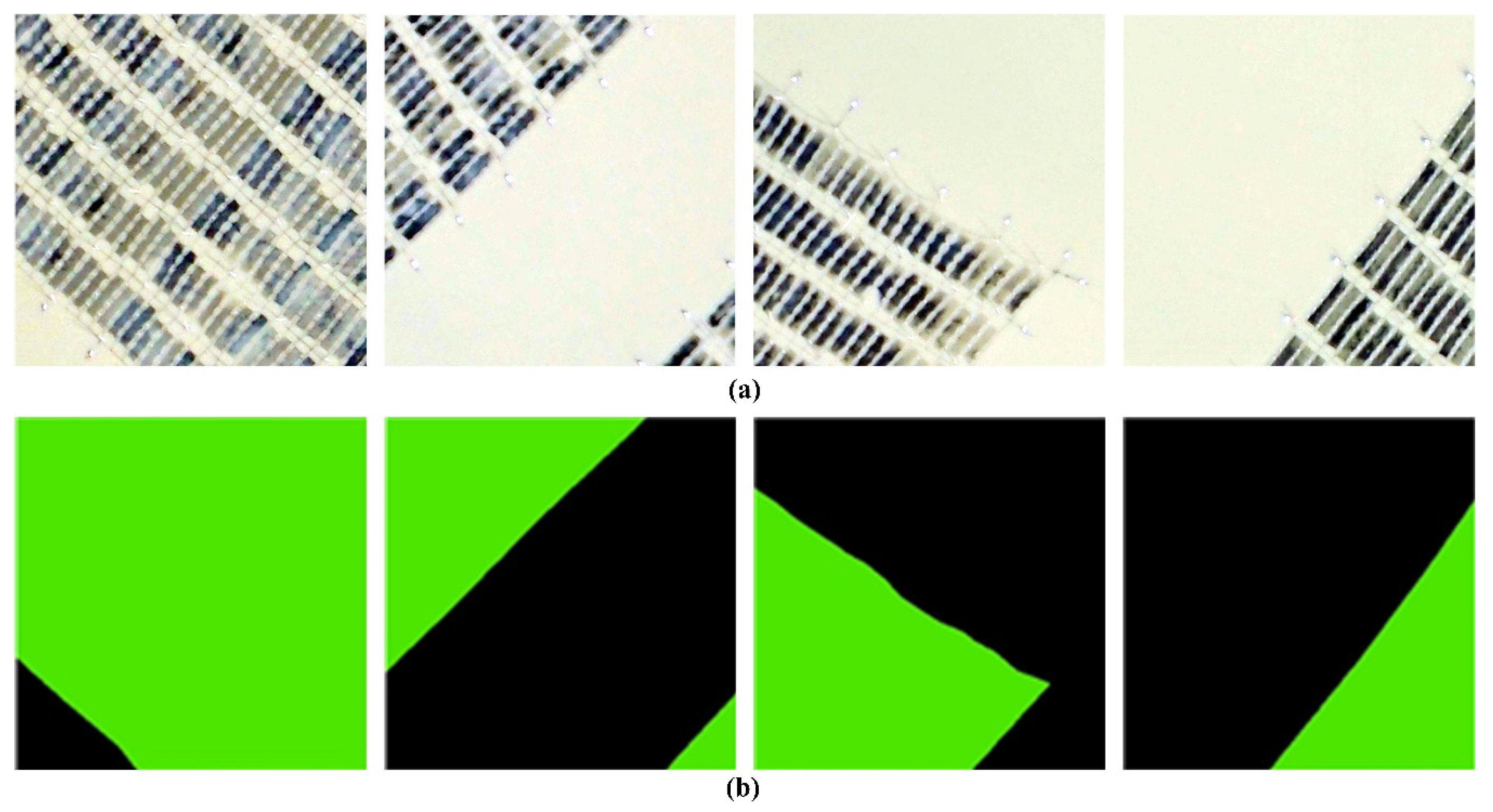
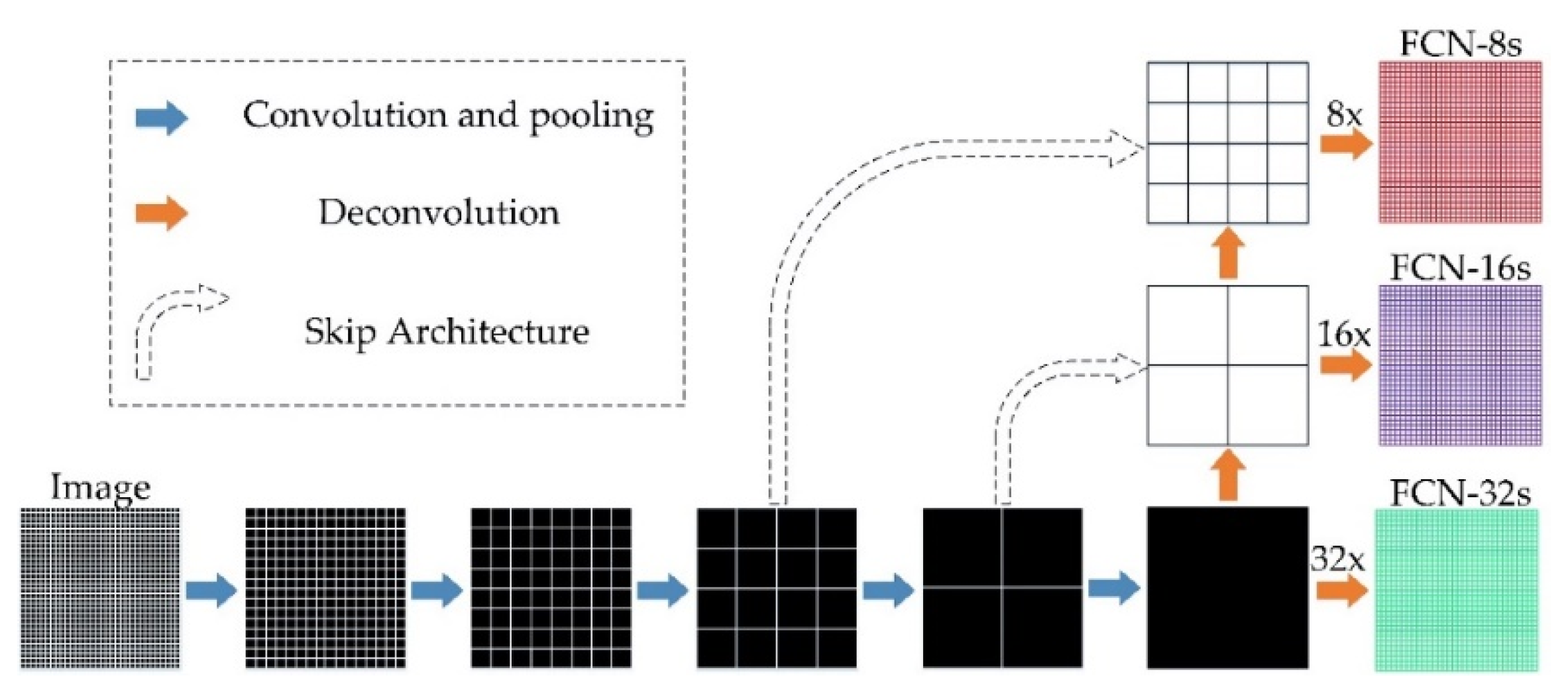




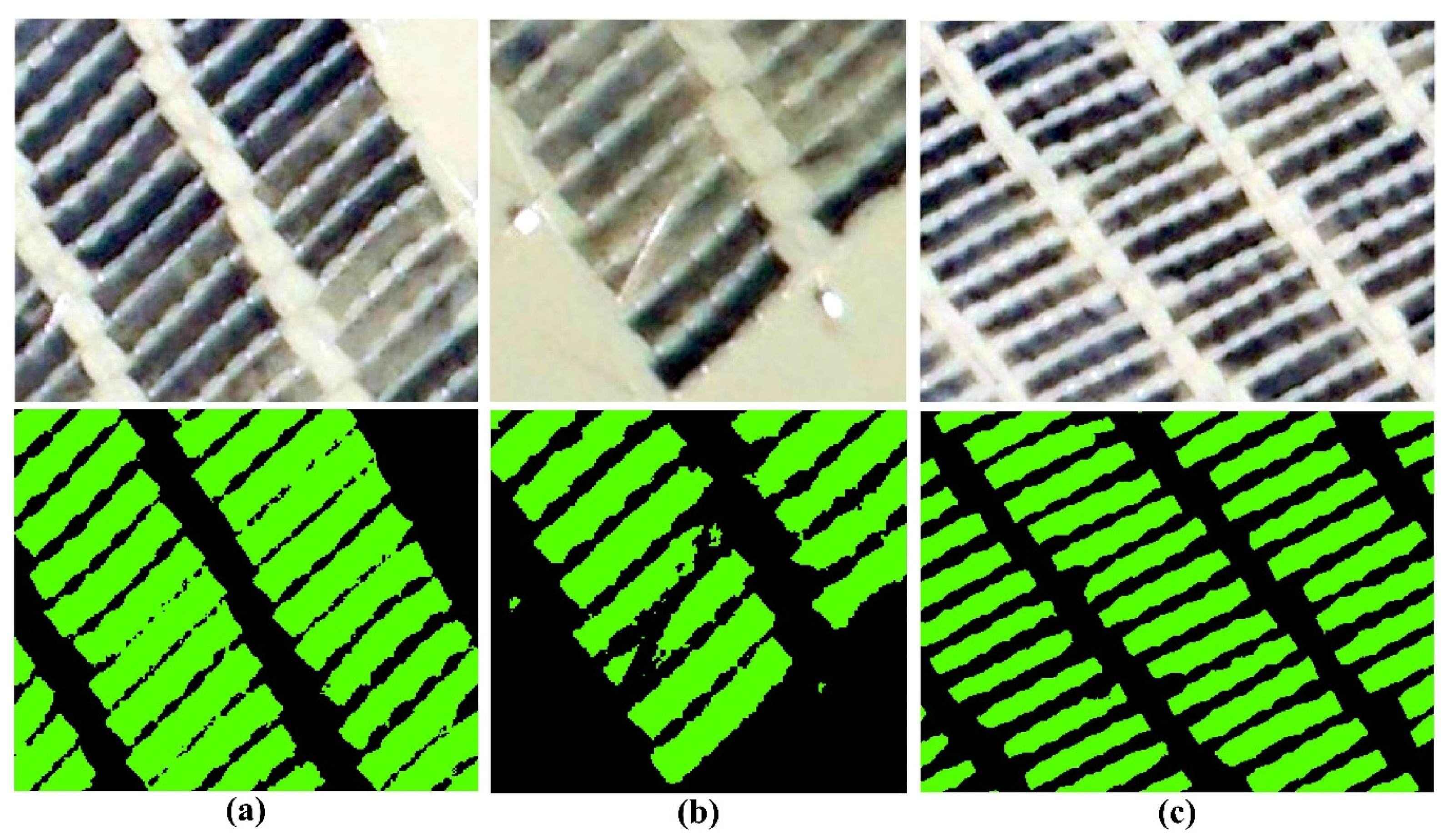
| Software and Hardware | Name |
|---|---|
| Central processing unit | Intel(R) Xeon(R) Gold 5118 |
| Graphics card | NVIDIA GeForce GTX1080 Ti |
| Video Memory | 16 GB |
| Operating system | Centos 7 |
| Programming language | Python |
| Function Library | Tensorflow, gdal, numpy, os, etc. |
| Structure | ||||
|---|---|---|---|---|
| FCN-8s | 98.4 | 99 | 99 | 99 |
| FCN-16s | 98.0 | 98 | 99 | 99 |
| FCN-32s | 95.2 | 95 | 98 | 96 |
| Methods | ||||
|---|---|---|---|---|
| MLC | 83.3 | 88 | 86 | 87 |
| SVM | 75.8 | 76 | 87 | 81 |
| NN | 73.7 | 96 | 66 | 78 |
| FCN | 98.4 | 99 | 99 | 99 |
| Confusion Matrix | Predicted Class | |||
|---|---|---|---|---|
| Mariculture Zones | Seawater | ALL | ||
| Actual class | Mariculture zones | 102,061,026 | 1,194,492 | 103,255,518 |
| Seawater | 1,302,421 | 374,134,673 | 375,437,094 | |
| ALL | 103,363,447 | 375,329,165 | 478,692,612 | |
| Parameter Name | Epoch | |||
|---|---|---|---|---|
| CRF_1 | 500 | 20 | 20 | 1 |
| CRF_2 | 500 | 10 | 20 | 10 |
| CRF_3 | 200 | 20 | 20 | 10 |
| CRF_4 | 500 | 20 | 20 | 10 |
| Experimental Project | Area of the Aquaculture Zone (m2) | Area of the Net (m2) | Number of Nets (piece) |
|---|---|---|---|
| Predicted result | 45,301.04 | 25,220.45 | 1516 |
© 2020 by the authors. Licensee MDPI, Basel, Switzerland. This article is an open access article distributed under the terms and conditions of the Creative Commons Attribution (CC BY) license (http://creativecommons.org/licenses/by/4.0/).
Share and Cite
Pan, X.; Jiang, T.; Zhang, Z.; Sui, B.; Liu, C.; Zhang, L. A New Method for Extracting Laver Culture Carriers Based on Inaccurate Supervised Classification with FCN-CRF. J. Mar. Sci. Eng. 2020, 8, 274. https://doi.org/10.3390/jmse8040274
Pan X, Jiang T, Zhang Z, Sui B, Liu C, Zhang L. A New Method for Extracting Laver Culture Carriers Based on Inaccurate Supervised Classification with FCN-CRF. Journal of Marine Science and Engineering. 2020; 8(4):274. https://doi.org/10.3390/jmse8040274
Chicago/Turabian StylePan, Xinliang, Tao Jiang, Zhen Zhang, Baikai Sui, Chenxi Liu, and Linjing Zhang. 2020. "A New Method for Extracting Laver Culture Carriers Based on Inaccurate Supervised Classification with FCN-CRF" Journal of Marine Science and Engineering 8, no. 4: 274. https://doi.org/10.3390/jmse8040274
APA StylePan, X., Jiang, T., Zhang, Z., Sui, B., Liu, C., & Zhang, L. (2020). A New Method for Extracting Laver Culture Carriers Based on Inaccurate Supervised Classification with FCN-CRF. Journal of Marine Science and Engineering, 8(4), 274. https://doi.org/10.3390/jmse8040274





